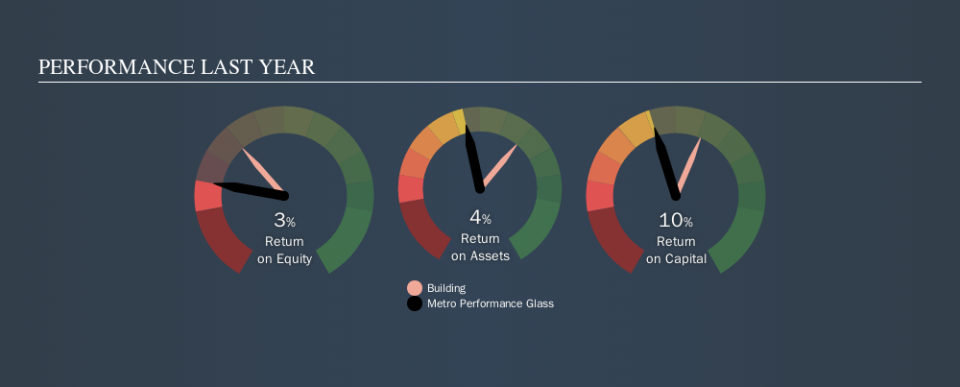Evaluating Metro Performance Glass Limited’s (NZSE:MPG) Investments In Its Business

Today we'll evaluate Metro Performance Glass Limited (NZSE:MPG) to determine whether it could have potential as an investment idea. Specifically, we'll consider its Return On Capital Employed (ROCE), since that will give us an insight into how efficiently the business can generate profits from the capital it requires.
Firstly, we'll go over how we calculate ROCE. Second, we'll look at its ROCE compared to similar companies. Last but not least, we'll look at what impact its current liabilities have on its ROCE.
What is Return On Capital Employed (ROCE)?
ROCE measures the 'return' (pre-tax profit) a company generates from capital employed in its business. All else being equal, a better business will have a higher ROCE. Ultimately, it is a useful but imperfect metric. Author Edwin Whiting says to be careful when comparing the ROCE of different businesses, since 'No two businesses are exactly alike.
How Do You Calculate Return On Capital Employed?
Analysts use this formula to calculate return on capital employed:
Return on Capital Employed = Earnings Before Interest and Tax (EBIT) ÷ (Total Assets - Current Liabilities)
Or for Metro Performance Glass:
0.099 = NZ$25m ÷ (NZ$289m - NZ$34m) (Based on the trailing twelve months to March 2019.)
Therefore, Metro Performance Glass has an ROCE of 9.9%.
View our latest analysis for Metro Performance Glass
Is Metro Performance Glass's ROCE Good?
ROCE can be useful when making comparisons, such as between similar companies. Using our data, Metro Performance Glass's ROCE appears to be around the 10% average of the Building industry. Aside from the industry comparison, Metro Performance Glass's ROCE is mediocre in absolute terms, considering the risk of investing in stocks versus the safety of a bank account. It is possible that there are more rewarding investments out there.
Metro Performance Glass's current ROCE of 9.9% is lower than its ROCE in the past, which was 15%, 3 years ago. So investors might consider if it has had issues recently. The image below shows how Metro Performance Glass's ROCE compares to its industry, and you can click it to see more detail on its past growth.
It is important to remember that ROCE shows past performance, and is not necessarily predictive. Companies in cyclical industries can be difficult to understand using ROCE, as returns typically look high during boom times, and low during busts. ROCE is only a point-in-time measure. Since the future is so important for investors, you should check out our free report on analyst forecasts for Metro Performance Glass.
Do Metro Performance Glass's Current Liabilities Skew Its ROCE?
Short term (or current) liabilities, are things like supplier invoices, overdrafts, or tax bills that need to be paid within 12 months. The ROCE equation subtracts current liabilities from capital employed, so a company with a lot of current liabilities appears to have less capital employed, and a higher ROCE than otherwise. To check the impact of this, we calculate if a company has high current liabilities relative to its total assets.
Metro Performance Glass has total assets of NZ$289m and current liabilities of NZ$34m. As a result, its current liabilities are equal to approximately 12% of its total assets. This very reasonable level of current liabilities would not boost the ROCE by much.
What We Can Learn From Metro Performance Glass's ROCE
With that in mind, we're not overly impressed with Metro Performance Glass's ROCE, so it may not be the most appealing prospect. But note: make sure you look for a great company, not just the first idea you come across. So take a peek at this free list of interesting companies with strong recent earnings growth (and a P/E ratio below 20).
For those who like to find winning investments this free list of growing companies with recent insider purchasing, could be just the ticket.
We aim to bring you long-term focused research analysis driven by fundamental data. Note that our analysis may not factor in the latest price-sensitive company announcements or qualitative material.
If you spot an error that warrants correction, please contact the editor at editorial-team@simplywallst.com. This article by Simply Wall St is general in nature. It does not constitute a recommendation to buy or sell any stock, and does not take account of your objectives, or your financial situation. Simply Wall St has no position in the stocks mentioned. Thank you for reading.

 Yahoo Finance
Yahoo Finance 
